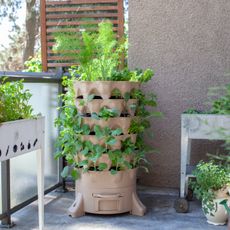History Of Crème Brulee Tomatoes

You love crème brulee, you've gotta love Crème Brulee tomato plants, right? Wrong! The jury is out about this heirloom variety: some gardeners find the taste an intriguing sweet/savory mix, others are disappointed in its mushy consistency and unusual flavor. You'll have to try it yourself since the gardener's vote counts most.
History of Crème Brulee Tomatoes
Given crème brulee's French heritage, you might assume that the history of Crème Brulee tomatoes would begin in La France, but it ain't so, Joe. These heirloom tomatoes come from Russia and were brought into the country by Baker Creek Heirloom Seeds. Their scientific name is Lycopersicon lycopersicum. If you aren't sure what the term "heirloom" means when applied to veggies, you're not alone. Heirloom started off as a description of a vegetable or plant variety with such excellent characteristics that it was passed down through several generations of a family. All heirloom plants are open pollinated and genetically unique, with an evolved resistance to pests and diseases that other types of vegetables lack. Unfortunately, some commercial vendors have played fast and loose with the term "heirloom." You may see it used commercially to mean open-pollinated varieties introduced before 1940, or tomato varieties more than 50 years in circulation.
Growing Heirloom Tomatoes
Almost everyone agrees that Crème Brulee heritage tomatoes are attractive. The ripe tomatoes are perfectly round and about the size of a baseball. They are a darkish red color, sometimes caramel colored or rusty red with hints of chocolate or deep green. These tomatoes take an average amount of time to ripen, and you'll be able to taste them sometime around 69 to 80 days. The taste is trickier to describe. These heirlooms are sweet, but also have a savory flavor. Some find it less sweet than expected, more like melon sweet than dessert sweet, and the name probably comes from the caramel color, not the taste. It is an interesting and complex flavor and a beautiful fruit - clearly a tomato variety worth trying.
Gardening tips, videos, info and more delivered right to your inbox!
Sign up for the Gardening Know How newsletter today and receive a free download of our most popular eBook "How to Grow Delicious Tomatoes."

Teo Spengler has been gardening for 30 years. She is a docent at the San Francisco Botanical Garden. Her passion is trees, 250 of which she has planted on her land in France.
-
 Clever Vertical Vegetable Garden Ideas For Small Spaces – 7 Ways To Save Space
Clever Vertical Vegetable Garden Ideas For Small Spaces – 7 Ways To Save SpaceShort on garden space? Learn some vegetable garden ideas for small spaces that are fun and easy.
By Mary Ellen Ellis
-
 26 Different Types Of Orchids – With Pictures & Information
26 Different Types Of Orchids – With Pictures & InformationDiscover stunning orchid types to grow in your home and garden – from easy beginner varieties to rare and exotic species that are the preserve of experts.
By Melanie Griffiths